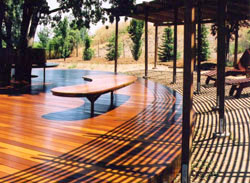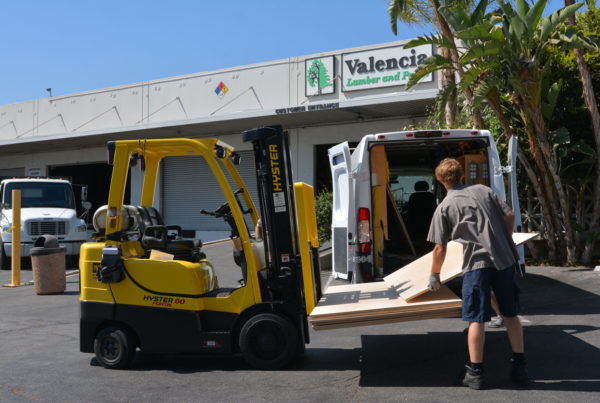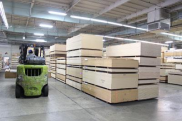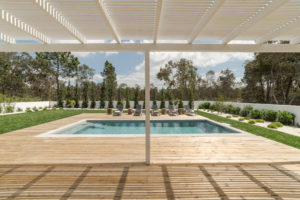
Modern house with garden swimming pool and wooden deck
It’s true: nothing beats the beauty of a natural wood deck.
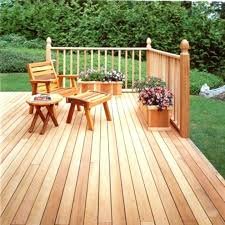
Western Red Cedar
Varying grains, every one a unique look, and they exude warmth and comfort. It’s true that composite decking offers a huge range of color choices, but it has yet to replace the character that natural wood decking offers.
Let’s look back a bit…
It feels like decks have been around forever, but we didn’t really start utilizing these outdoor spaces until the 80’s, driven by the trend toward outdoor cooking and entertaining.
In the 70’s and 80’s, you could have a deck built out of anything, as long as it was wood. Doug Fir and Pine were big in the Eastern half of the country. The advantages offered by Pressure-treated Pine moved that product to the front of the pack (before some of its shortcomings became apparent).
Out on the West Coast, Redwood and Western Red Cedar were the decking materials of choice, and they remain so, especially if you opt for higher grades. They are readily available and relatively inexpensive compared to hardwoods and composites. Insect- and rot-resistant, these two primary softwood species add beauty and value to any home.
Here come the tropicals…
In the mid-90’s, eco-consciousness gave rise to responsible forestry practices outside of North America. This resulted in a reliable supply of tropical hardwoods and these became viable options to softwoods. Ipe (shown here), Teak, Mangaris (Red Balau) and others offer luxurious looks and durability that softwoods cannot match. Extremely dense and hard, each with its own characteristic beauty, these species stand up to any weather and laugh at insects and rot.
The design and size of decks have dramatically changed since the early days of forgettable 8-foot-by-10-foot rectangles. We live outdoors: cooking, eating, entertaining, hot-tubbing, lounging around. About the only thing we don’t do with our wooden decks is maintain them, but that’s a topic for another day.
Let’s look at some of the other benefits of building with wood, and why it remains such a popular choice for decks.
IT’S VERSATILE
From an aesthetic viewpoint, in its natural state wood offers a variety of grain patterns and colors. And it can be stained to a hue that complements your home, while preserving the texture of the wood grain. And because it can be milled in virtually any dimension, wood offers versatility in design and construction: perfect for all kinds of outdoor applications, from fences to decks to gazebos to pergolas. Even for natural “tiling” on patio surfaces.
IT’S AFFORDABLE
Compared with other materials, like composites, wood is generally much more affordable. Softwoods in particular tend to be cheaper than hardwoods because they are not as expensive to produce (well, they also grow a lot faster, so there’s that). They’re also easier to cut, saw, shape, nail and screw, which reduces labor cost. It’s possible you could build a softwood deck twice as big as a composite deck for the same cost. (But do remember that that softwood deck will require a lot of upkeep, clean and finish about every two years).
BETTER ROI
One of the highest return-on-investment projects for a homeowner is the addition of a wooden deck: about 83%, according to the 2018 Cost vs Value Report. That’s due the appeal of wooden decks to buyers and it’s considerably higher than for composite decks (68%).
SUSTAINABLITY
Wood is the only naturally-renewable mainstream building material. It’s not manufactured, it grows organically. If people all walked off the job, no composite decking would be made, but trees would keep growing. More lumber grows in the U.S. than is harvested every year. (Here’s something that might surprise you). Responsible forestry practices keep our environment healthy.
Climate change can be mitigated by building with wood as well. Carbon dioxide is absorbed by trees and is sequestered in the wood itself. When the trees are harvested, processed into lumber and used for building, that stored carbon continues to be trapped. It will only return to the atmosphere if that wood burns or decays.
HEALTH AND WELLNESS
Do you feel better when you’re out in nature? Do you sleep like a baby after a long day at the beach or in the mountains? (Do you have a baby? You probably don’t sleep. Ignore the last line).
Incorporating natural materials in the design of a home can lead to improved well-being overall. Adding wood, stone, water and plants to your living space, and letting in sunlight, is the foundation of biophilic design, and is as important as nutrition and exercise. Studies show that people unconsciously relax in environments surrounded with natural elements like wood. It’s true: for some reason, wooden decks just feel better than composite decks.
DURABILITY
How long has that deck of yours been sitting on top of that pressure-treated substructure? Probably a long long time. The load-bearing strength and elasticity of pressure-treated lumber makes it the ideal material for deck framing and substructure. That’s something you appreciate when you live in earthquake country.
So, guess what we build our composite decks on top of? Yup- Wood.
Explore our other plywood panels and accessories. Visit our hardwood store in Van Nuys.

